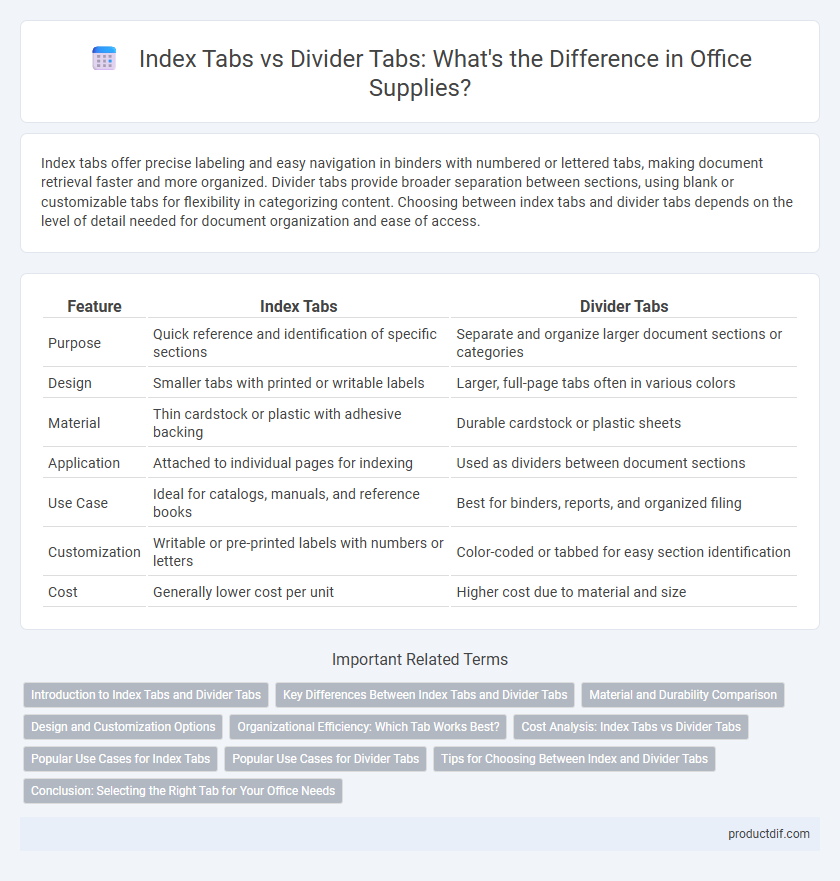Index tabs offer precise labeling and easy navigation in binders with numbered or lettered tabs, making document retrieval faster and more organized. Divider tabs provide broader separation between sections, using blank or customizable tabs for flexibility in categorizing content. Choosing between index tabs and divider tabs depends on the level of detail needed for document organization and ease of access.
Table of Comparison
| Feature | Index Tabs | Divider Tabs |
|---|---|---|
| Purpose | Quick reference and identification of specific sections | Separate and organize larger document sections or categories |
| Design | Smaller tabs with printed or writable labels | Larger, full-page tabs often in various colors |
| Material | Thin cardstock or plastic with adhesive backing | Durable cardstock or plastic sheets |
| Application | Attached to individual pages for indexing | Used as dividers between document sections |
| Use Case | Ideal for catalogs, manuals, and reference books | Best for binders, reports, and organized filing |
| Customization | Writable or pre-printed labels with numbers or letters | Color-coded or tabbed for easy section identification |
| Cost | Generally lower cost per unit | Higher cost due to material and size |
Introduction to Index Tabs and Divider Tabs
Index tabs are small, labeled markers used to organize and quickly locate sections within documents, notebooks, or binders. Divider tabs serve as larger, often colored, separators that divide content into broader categories, enhancing overall document navigation. Both tools improve file management by providing clear visual cues and easy access to information.
Key Differences Between Index Tabs and Divider Tabs
Index tabs organize documents by labeled categories, making it easier to locate specific sections through alphanumeric or color-coded markers. Divider tabs separate sections physically within binders or folders without necessarily providing a detailed labeling system. The main difference lies in index tabs offering precise identification and quick reference, while divider tabs primarily serve as physical separators.
Material and Durability Comparison
Index tabs are typically made from higher-grade paper or plastic materials ensuring enhanced durability and resistance to tearing, ideal for frequent use. Divider tabs often utilize thinner cardstock or laminated paper, which provides sufficient sturdiness but may wear out faster under heavy handling. The choice between index and divider tabs should prioritize the material quality for longevity, with plastic index tabs outperforming most divider tabs in durability.
Design and Customization Options
Index tabs feature clear labeling areas and color-coded options ideal for quick identification and organization in office settings. Divider tabs offer more extensive customization with printable surfaces and various materials, allowing personalized designs to match branding or specific categorization needs. Both types support efficient document management, but divider tabs excel in flexibility for creative and professional presentations.
Organizational Efficiency: Which Tab Works Best?
Index tabs provide clear, labeled sections that enhance quick reference and retrieval in files, making them ideal for detailed document organization. Divider tabs offer broader separation of major sections, simplifying overall file structure and reducing clutter. Choosing between index tabs and divider tabs depends on the level of granularity needed, with index tabs supporting precision and divider tabs facilitating general categorization.
Cost Analysis: Index Tabs vs Divider Tabs
Index tabs generally offer a cost-effective solution with lower per-unit prices, making them ideal for frequent reorganization in offices. Divider tabs, while often more expensive due to their thicker material and durability, provide long-term value by reducing replacement frequency. Businesses should weigh short-term savings of index tabs against the extended lifespan and sturdiness of divider tabs to optimize office supply budgets.
Popular Use Cases for Index Tabs
Index tabs are widely used for organizing documents in binders, allowing quick access to frequently referenced sections such as reports, manuals, or project files. They are ideal for categorizing and labeling content with customizable tabs that enhance workflow efficiency in offices, schools, and libraries. Divider tabs, in contrast, primarily separate larger sections but lack the detailed labeling flexibility that makes index tabs popular for intricate document management.
Popular Use Cases for Divider Tabs
Divider tabs are widely used for organizing large documents, such as reports, manuals, and binders, allowing quick access to specific sections or topics. They provide clear visual separation in presentations and legal files, making it easier to locate and reference important information. Commonly found in academic, professional, and administrative settings, divider tabs enhance efficiency by streamlining document navigation and improving workflow management.
Tips for Choosing Between Index and Divider Tabs
Index tabs offer clear labeling options, making them ideal for quick referencing and organization in extensive documents, while divider tabs provide visual separation and are better suited for categorizing broad sections. Consider the volume and type of content when choosing; index tabs work best for detailed, easily accessible sections, whereas divider tabs help users navigate large files at a glance. Assess your document's layout and functionality needs to decide which tab style enhances efficiency and usability in your office workflow.
Conclusion: Selecting the Right Tab for Your Office Needs
Index tabs offer clear labeling and quick access to frequently referenced documents, making them ideal for detailed organization in office settings. Divider tabs provide broader category separation and durability for extensive filing systems or binders, enhancing document management efficiency. Choosing the right tab depends on the complexity of your filing needs, with index tabs suited for granular detail and divider tabs for high-level document segmentation.
Index tabs vs Divider tabs Infographic

 productdif.com
productdif.com